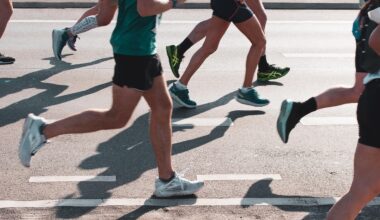Weightlifting Competitions: Emerging Trends and Training Programs
The fitness industry is continuously evolving, with weightlifting competitions gaining immense popularity among athletes. These competitions challenge individuals to not only test their maximum strength but also hone their techniques in a competitive environment. As more fitness enthusiasts aspire to enter these competitions, trends are emerging that shape the landscape of weightlifting. One significant trend is the increased focus on inclusivity, encouraging participation from various demographics. This is evident in community fitness challenges, where competitors range from beginners to seasoned lifters. Training programs tailored to specific weight classes and skill levels are on the rise, ensuring participants can improve their performance. Additionally, technology greatly enhances training methodologies, allowing athletes to track their progress with advanced apps and wearables. The integration of social media also plays a key role, as competitors often share their journeys and connect with a supportive community. Overall, the combination of inclusivity, technology, and community engagement is transforming the world of weightlifting competitions and shaping the future of fitness challenges.
The rise in popularity of weightlifting competitions has led to several trends in training regimens. Athletes are increasingly adopting periodization, a scientifically backed approach that emphasizes various training cycles. This method helps maintain motivation, reduces the risk of injury, and improves overall performance. Coaches now design individualized programs tailored to each athlete’s strengths and weaknesses, focusing on precise metrics such as volume and intensity. Another trend is the emphasis on functional strength training. This approach prepares athletes not just for competition but enhances their daily functional movement, which proves invaluable in everyday life. Nutrition also plays a pivotal role in sporting success. Enhancing performance through dietary adjustments has become commonplace. Athletes are more educated about macronutrients and supplementation. Moreover, mental conditioning is gaining traction, emphasizing the importance of psychological preparation. Visualization techniques and mindset training are now integrated into programs. As a result, the emphasis has shifted dramatically from purely physical attributes to a holistic approach in preparing for competitions. Ultimately, these trends are driving innovative training programs in the weightlifting sector, fostering a new generation of highly skilled competitors.
Technological Advancements in Training
Technology has made a profound impact on weightlifting training and competition. Smart devices and apps now provide athletes with unprecedented access to data, allowing them to analyze performance metrics in real-time. These tools enable competitors to track lifts, recovery times, and even fatigue levels, ensuring that their training is as efficient as possible. Furthermore, video analysis is becoming increasingly important. Many coaches utilize recorded lifts to offer feedback on form, which is crucial in preventing injuries and enhancing skill. Virtual competitions have emerged, particularly in light of recent global health challenges, offering an alternative way for athletes to compete remotely. This innovation expands participation and brings together lifters from diverse locations. Wearable technology, like fitness trackers, also contribute significantly to training strategies. They can monitor heart rates and exertion levels, enhancing the understanding of an athlete’s physical limits. This creates data-driven approaches to training that are personalized. The synergistic combination of technology and training is reshaping weightlifting competitions, allowing athletes to optimize their performance and prepare strategically for their events.
Furthermore, the community surrounding weightlifting competitions has witnessed considerable growth. Online communities provide a supportive environment where aspiring lifters can share their experiences and seek advice. These digital platforms allow for knowledge exchange and learning from elite lifters, inspiring newcomers. Social media has emerged as a vital tool for promoting competitions, allowing athletes and organizers to connect seamlessly. Many competitors now document their training journeys through platforms like Instagram, attracting followers and creating even greater motivation for themselves and others. Virtual events and challenges are becoming increasingly popular, encouraging individuals to engage without geographical limitations. Moreover, local gyms are stepping up to host more grassroots competitions, fostering a sense of community engagement. These events promote camaraderie and healthy competition among participants, facilitating personal growth and shared experiences. Engaging with the community can be especially beneficial for beginners who often feel intimidated by the competitive scene. As friendships form through shared challenges, the social aspect of weightlifting solidifies the bond among lifters. Building strong networks opens doors for collaborations and further pushes the sport into mainstream fitness culture.
Inclusivity and Accessibility
Inclusivity has become a vital focus in the weightlifting competition sphere. Organizers are increasingly aware of the need to create events that cater to athletes from diverse backgrounds, ages, and ability levels. Last year, several competitions introduced adaptive divisions to accommodate athletes with disabilities, thus paving the way for greater participation. Moreover, many gyms are now offering programs specifically designed to introduce beginners to weightlifting. These targeted initiatives help in reducing intimidation. This trend acknowledges that every athlete’s experience is unique. Inclusivity doesn’t only refer to physical abilities; diversity in gender representation is improving as well. Women’s participation has soared recently, accelerating with initiatives aimed at empowering female lifters. More competitions are actively promoting female-only sessions, thus creating safe environments for aspiring female athletes. Additionally, scholarships and sponsorships targeting underrepresented groups are gaining traction. These efforts emphasize that weightlifting is accessible to everyone. This broader participation not only enhances competition quality but cultivates a rich community dedicated to supporting one another. Through these initiatives, the weightlifting community grows stronger while embracing variety and individuality.
Nutrition has emerged as an essential aspect. Competitive weightlifting requires optimal fueling strategies for performance improvement. Therefore, nutrition programs tailored to specific training plans are becoming a standard practice. Competitors are focusing on pre- and post-workout nutrition, understanding that strategic eating enhances recovery. Plant-based diets are also becoming popular among athletes, promoting sustainable sources of energy. These diets are not only healthy but also align with a growing awareness of environmental impacts. Additionally, meal prepping has become fashionable as competitors attempt to streamline their eating habits amidst busy schedules. Weightlifting competitions emphasize the need for adequate hydration. Many competitors are introducing hydration plans. This proactive approach helps maintain performance levels. The incorporation of sports nutritionists in training programs enables athletes to unlock their full potential. Education around nutrition empowers competitors to make informed choices, ensuring they compete at their peak. Awareness around food intolerances and allergies is increasing, allowing athletes to adopt practices that support digestive health. Challenges faced by weightlifters are not only physical but require a commitment to nourishing the body effectively, enhancing their mental and physical capabilities.
The Future of Weightlifting Competitions
The future of weightlifting competitions appears bright, marked by the evolution of training methodologies, community engagement, and inclusivity. As more people recognize the benefits of resistance training, the demand for organized competitions will likely rise. Many athletes are exploring hybrid options blending traditional weightlifting with other training modalities, such as functional fitness. This trend could open new avenues for competition formats and challenges, ensuring that weightlifting remains relevant and engaging. Additionally, competitive sectors must embrace sustainable practices as environmental considerations become more central to sports. These practices may involve eco-friendly venues, promoting less waste, or incorporating recycled materials in promotions. With an increasing focus on mental health, programs prioritizing psychological well-being alongside physical training may also emerge. This could manifest as workshops emphasizing resilience, focus, and stress management. Moreover, technological advancements will continue to shape the competitions of tomorrow. Innovations in training tools and smarter analytics will revolutionize how athletes prepare. Ultimately, as weightlifting evolves, it will further enhance its role within the fitness community, fostering inclusion and empowering aspiring lifters to reach their full potential.
In conclusion, weightlifting competitions receive significant attention in the fitness world, demonstrating the industry’s rapid evolution. Emerging trends in training programs align with a modern understanding of performance and well-being. Inclusivity has transformed participation, opening doors for diverse athletes. Digital platforms have enhanced community engagement. The focus on mental and physical conditioning signifies the shifting paradigm of preparation strategies. Investment in nutrition and technological advancements contributes to the sport’s growth. Athletes now have access to resources that promote not just physical prowess but also mental resilience. The future of weightlifting competitions promises continued innovation, emphasizing holistic approaches that cater to individual needs. As new trends unfold, the trajectory of weightlifting evolves toward an inclusive, engaging, and sustainable future. Through these efforts, the fitness community grows stronger, whether aspiring lifters are just beginning or seasoned competitors aiming for excellence. Ultimately, weightlifting embodies the spirit of collaboration, personal growth, and the journey to success. By fostering a supportive environment, the weightlifting community enhances the experience for all, showcasing the profound impact of emerging trends and effectively bridging gaps in the fitness landscape. Building strong networks and encouraging participation fosters a resilient community, enriching the world of fitness.


